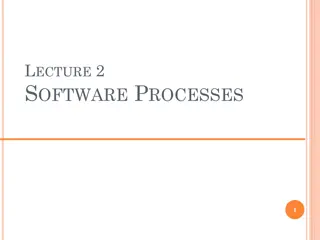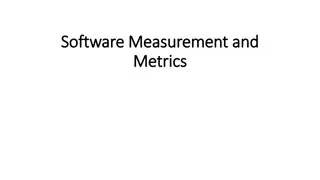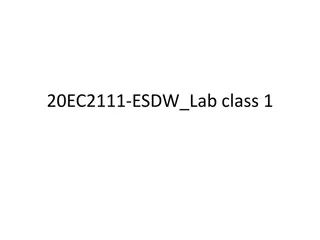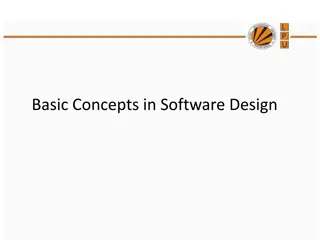CSE 331 Software Design & Implementation
Subtyping in software design refers to the relationship where a subtype can be used in place of a supertype. It ensures that objects satisfying the subtype's rules also satisfy the supertype's rules, promoting code flexibility and reusability. Subtyping allows for better design clarity, test sharing, and code reuse. It is crucial to distinguish between true subtypes and Java subtypes to avoid confusion and maintain code integrity. Furthermore, subtyping differs from subclassing, where inheritance simplifies adding functionality to classes. This concept is illustrated through examples and comparisons in the context of software design principles.
Download Presentation

Please find below an Image/Link to download the presentation.
The content on the website is provided AS IS for your information and personal use only. It may not be sold, licensed, or shared on other websites without obtaining consent from the author.If you encounter any issues during the download, it is possible that the publisher has removed the file from their server.
You are allowed to download the files provided on this website for personal or commercial use, subject to the condition that they are used lawfully. All files are the property of their respective owners.
The content on the website is provided AS IS for your information and personal use only. It may not be sold, licensed, or shared on other websites without obtaining consent from the author.
E N D
Presentation Transcript
CSE 331 Software Design & Implementation Dan Grossman Winter 2014 Subtypes and Subclasses (Based on slides by Mike Ernst, David Notkin, Hal Perkins)
What is subtyping? LibraryHolding A Sometimes every B is an A Example: In a library database: Every book is a library holding Every CD is a library holding Book CD B Shape Subtyping expresses this B is a subtype of A means: every object that satisfies the rules for a B also satisfies the rules for an A Rhombus Circle Goal: code written using A's specification operates correctly even if given a B Plus: clarify design, share tests, (sometimes) share code CSE331 Winter 2014 2
Subtypes are substitutable Subtypes are substitutable for supertypes Instances of subtype won't surprise client by failing to satisfy the supertype's specification Instances of subtype won't surprise client by having more expectations than the supertype's specification We say that B is a true subtypeof A if B has a stronger specification than A This is not the same as a Java subtype Java subtypes that are not true subtypes are confusing and dangerous But unfortunately common poor-design CSE331 Winter 2014 3
Subtyping vs. subclassing Substitution (subtype) a specification notion B is a subtype of A iff an object of B can masquerade as an object of A in any context About satisfiability (behavior of a B is a subset of A s spec) Inheritance (subclass) an implementation notion Factor out repeated code To create a new class, write only the differences Java purposely merges these notions for classes: Every subclass is a Java subtype But not necessarily a true subtype CSE331 Winter 2014 4
Inheritance makes adding functionality easy Suppose we run a web store with a class for products class Product { private String title; private String description; private int price; // in cents public int getPrice() { return price; } public int getTax() { return (int)(getPrice() * 0.095f); } ... } ... and we need a class for products that are on sale CSE331 Winter 2014 5
We know: dont copy code! We would never dream of cutting and pasting like this: class SaleProduct { private String title; private String description; private int price; // in cents private float factor; public int getPrice() { return (int)(price*factor); } public float getTax() { return getPrice() * .095; } } CSE331 Winter 2014 6
Inheritance makes small extensions small Much better: class SaleProduct extends Product { private float factor; public int getPrice() { return (int)(super.getPrice()*factor); } } CSE331 Winter 2014 7
Benefits of subclassing & inheritance Don t repeat unchanged fields and methods In implementation Simpler maintenance: fix bugs once In specification Clients who understand the superclass specification need only study novel parts of the subclass Modularity: can ignore private fields and methods of superclass (if properly defined) Differences not buried under mass of similarities Ability to substitute new implementations No client code changes required to use new subclasses CSE331 Winter 2014 8
Subclassing can be misused Poor planning can lead to a muddled class hierarchy Relationships may not match untutored intuition Poor design can produce subclasses that depend on many implementation details of superclasses Changes in superclasses can break subclasses fragile base class problem Subtyping and implementation inheritance are orthogonal! Subclassing gives you both Sometimes you want just one Interfaces: subtyping without inheritance [see also section] Composition: use implementation without subtyping Can seem less convenient, but often better long-term CSE331 Winter 2014 9
Is every square a rectangle? interface Rectangle { // effects: fits shape to given size: // thispost.width = w, thispost.height = h void setSize(int w, int h); } interface Square extends Rectangle { } Which is the best option for Square.setSize()? 1. // requires: w = h // effects: fits shape to given size void setSize(int w, int h); 2.// effects: sets all edges to given size void setSize(int edgeLength); 3.// effects: sets this.width and this.height to w void setSize(int w, int h); 4. // effects: fits shape to given size // throws BadSizeException if w != h void setSize(int w, int h) throws BadSizeException; CSE331 Winter 2014 10
Square, Rectangle Unrelated (Subtypes) Rectangle Square not a (true subtype of) Rectangle: Rectangles are expected to have a width and height that can be mutated independently Squares violate that expectation, could surprise client Square Rectangle not a (true subtype of) Square: Squares are expected to have equal widths and heights Rectangles violate that expectation, could surprise client Square Subtyping not always intuitive Benefit: it forces clear thinking and prevents errors Rectangle Shape Solutions: Make them unrelated (or siblings) Make them immutable (!) Recovers elementary-school intuition Square Rectangle CSE331 Winter 2014 11
Inappropriate subtyping in the JDK class Hashtable<K,V> { public void put(K key, V value){ } public V get(K key){ } } // Keys and values are strings. class Properties extends Hashtable<Object,Object> { public void setProperty(String key, String val) { put(key,val); } public String getProperty(String key) { return (String)get(key); } } Properties p = new Properties(); Hashtable tbl = p; tbl.put("One", 1); p.getProperty("One"); // crash! CSE331 Winter 2014 12
Violation of rep invariant Properties class has a simple rep invariant: Keys and values are Strings But client can treat Properties as a Hashtable Can put in arbitrary content, break rep invariant From Javadoc: Because Properties inherits from Hashtable, the put and putAll methods can be applied to a Properties object. ... If the store or save method is called on a "compromised" Properties object that contains a non-String key or value, the call will fail. CSE331 Winter 2014 13
Solution 1: Generics Bad choice: class Properties extends Hashtable<Object,Object> { } Better choice: class Properties extends Hashtable<String,String> { } JDK designers deliberately didn t do this. Why? Backward-compatibility (Java didn t used to have generics) Postpone talking about generics: upcoming lecture CSE331 Winter 2014 14
Solution 2: Composition class Properties { private Hashtable<Object, Object> hashtable; public void setProperty(String key, String value) { hashtable.put(key,value); } public String getProperty(String key) { return (String) hashtable.get(key); } } CSE331 Winter 2014 15
Substitution principle for classes If B is a subtype of A, a B can always be substituted for an A Any property guaranteed by A must be guaranteed by B Anything provable about an A is provable about a B If an instance of subtype is treated purely as supertype (only supertype methods/fields used), then the result should be consistent with an object of the supertype being manipulated B is permitted to strengthen properties and add properties Fine to add new methods (that preserve invariants) An overriding method must have a stronger (or equal) spec B is not permitted to weaken a spec No method removal No overriding method with a weaker spec CSE331 Winter 2014 16
Substitution principle for methods Constraints on methods For each supertype method, subtype must have such a method Could be inherited or overridden Each overriding method must strengthen (or match) the spec: Ask nothing extra of client ( weaker precondition ) Requires clause is at most as strict as in supertype s method Guarantee at least as much ( stronger postcondition ) Effects clause is at least as strict as in the supertype method No new entries in modifies clause Promise more (or the same) in returns clause Throws clause must indicate fewer (or same) possible exception types CSE331 Winter 2014 17
Spec weakening for argument/result types A Method inputs: Argument types in A s foo may be replaced with supertypes in B s foo ( contravariance ) Places no extra demand on the clients But Java does not have such overriding (Why?) Method results: Result type of A s foo may be replaced by a subtype in B s foo ( covariance ) No new exceptions (for values in the domain) Existing exceptions can be replaced with subtypes (None of this violates what client can rely on) LibraryHolding B Book CD Shape Circle Rhombus CSE331 Winter 2014 18
Substitution exercise Suppose we have a method which, when given one product, recommends another: class Product { Product recommend(Product ref); } Which of these are possible forms of this method in SaleProduct (a true subtype of Product)? Product recommend(SaleProduct ref); SaleProduct recommend(Product ref); Product recommend(Object ref); // bad // OK // OK, but is Java overloading Product recommend(Product ref) // bad throws NoSaleException; CSE331 Winter 2014 19
Java subtyping Java types: Defined by classes, interfaces, primitives Java subtyping stems from B extends Aand B implements A declarations In a Java subtype, each corresponding method has: Same argument types If different, overloading: unrelated methods Compatible (covariant) return types A (somewhat) recent language feature, not reflected in (e.g.) clone No additional declared exceptions CSE331 Winter 2014 20
Java subtyping guarantees A variable s run-time type (i.e., the class of its run-time value) is a Java subtype of its declared type Object o = new Date(); // OK Date d = new Object(); // compile-time error If a variable of declared (compile-time) type T1 holds a reference to an object of actual (runtime) type T2, then T1 must be a Java subtype of T2 Corollaries: Objects always have implementations of the methods specified by their declared type If all subtypes are true subtypes, then all objects meet the specification of their declared type Rules out a huge class of bugs CSE331 Winter 2014 21
Inheritance can break encapsulation public class InstrumentedHashSet<E> extends HashSet<E> { private int addCount = 0; // count # insertions public InstrumentedHashSet(Collection<? extends E> c){ super(c); } public boolean add(E o) { addCount++; return super.add(o); } public boolean addAll(Collection<? extends E> c) { addCount += c.size(); return super.addAll(c); } public int getAddCount() { return addCount; } } CSE331 Winter 2014 22
Dependence on implementation What does this code print? InstrumentedHashSet<String> s = new InstrumentedHashSet<String>(); System.out.println(s.getAddCount()); s.addAll(Arrays.asList("CSE", "331")); System.out.println(s.getAddCount()); // 0 // 4?! Answer depends onimplementation of addAll in HashSet Different implementations may behave differently! If HashSet saddAll calls add, then double-counting AbstractCollection saddAll specification: Adds all of the elements in the specified collection to this collection. Does not specify whether it calls add Lesson: Subclassing often requires designing for extension CSE331 Winter 2014 23
Solutions 1. Change spec of HashSet Indicate all self-calls Less flexibility for implementers of specification 2. Avoid spec ambiguity by avoiding self-calls a) Re-implement methods such as addAll Requires re-implementing methods b) Use a wrapper No longer a subtype (unless an interface is handy) Bad for callbacks, equality tests, etc. CSE331 Winter 2014 24
Solution 2b: composition Delegate public class InstrumentedHashSet<E> { private final HashSet<E> s = new HashSet<E>(); private int addCount = 0; public InstrumentedHashSet(Collection<? extends E> c){ this.addAll(c); } public boolean add(E o) { addCount++; return s.add(o); } public boolean addAll(Collection<? extends E> c) { addCount += c.size(); return s.addAll(c); } public int getAddCount() { return addCount; } // ... and every other method specified by HashSet<E> } CSE331 Winter 2014 The implementation no longer matters 25
Composition (wrappers, delegation) Implementation reuse without inheritance Easy to reason about; self-calls are irrelevant Example of a wrapper class Works around badly-designed / badly-specified classes Disadvantages (may be worthwhile price to pay): Does not preserve subtyping Tedious to write (your IDE should help you) May be hard to apply to callbacks, equality tests CSE331 Winter 2014 26
Composition does not preserve subtyping InstrumentedHashSet is not a HashSet anymore So can't easily substitute it It may be a true subtype of HashSet But Java doesn't know that! Java requires declared relationships Not enough just to meet specification Interfaces to the rescue Can declare that we implement interface Set If such an interface exists CSE331 Winter 2014 27
Avoid encoding implementation details Interfaces reintroduce Java subtyping public class InstrumentedHashSet<E> implements Set<E>{ private final Set<E> s = new HashSet<E>(); private int addCount = 0; public InstrumentedHashSet(Collection<? extends E> c){ this.addAll(c); } public boolean add(E o) { addCount++; return s.add(o); } public boolean addAll(Collection<? extends E> c) { addCount += c.size(); return s.addAll(c); } public int getAddCount() { return addCount; } // ... and every other method specified by Set<E> } CSE331 Winter 2014 What s bad about this constructor? InstrumentedHashSet(Set<E> s) { this.s = s; addCount = s.size(); } 28
Interfaces and abstract classes Provide interfaces for your functionality Client code to interfaces rather than concrete classes Allows different implementations later Facilitates composition, wrapper classes Basis of lots of useful, clever techniques We'll see more of these later Consider also providing helper/template abstract classes Can minimize number of methods that new implementation must provide Makes writing new implementations much easier Not necessary to use them to implement an interface, so retain freedom to create radically different implementations that meet an interface CSE331 Winter 2014 29
Java library interface/class example // root interface of collection hierarchy interface Collection<E> // skeletal implementation of Collection<E> abstract class AbstractCollection<E> implements Collection<E> // type of all ordered collections interface List<E> extends Collection<E> // skeletal implementation of List<E> abstract class AbstractList<E> extends AbstractCollection<E> implements List<E> // an old friend... class ArrayList<E> extends AbstractList<E> CSE331 Winter 2014 30
Why interfaces instead of classes Java design decisions: A class has exactly one superclass A class may implement multiple interfaces An interface may extend multiple interfaces Observation: Multiple superclasses are difficult to use and to implement Multiple interfaces, single superclass gets most of the benefit CSE331 Winter 2014 31
Pluses and minuses of inheritance Inheritance is a powerful way to achieve code reuse Inheritance can break encapsulation A subclass may need to depend on unspecified details of the implementation of its superclass E.g., pattern of self-calls Subclass may need to evolve in tandem with superclass Okay within a package where implementation of both is under control of same programmer Authors of superclass should design and document self-use, to simplify extension Otherwise, avoid implementation inheritance and use composition instead CSE331 Winter 2014 32



















